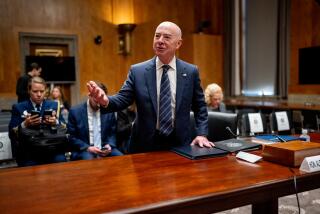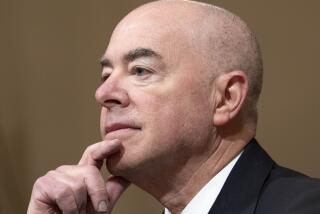Column: This is my third impeachment. Here’s what I’ve learned.

- Share via
WASHINGTON — In 1973, as a student journalist, I stood against the back wall of the ornate Senate Caucus Room and scribbled notes as the Senate Watergate Committee held hearings on the tangled misdeeds of President Nixon.
I listened as John W. Dean, Nixon’s former counsel, said he had warned of “a cancer on the presidency.”
In 1999, as a Times reporter, I stood in the Senate Press Gallery and watched senators solemnly pronounce their verdicts in the impeachment trial of President Clinton, including, on one count, a carefully choreographed 50-50 tie.
And last week, I watched House Democrats launch the third formal effort to impeach a president in the last half century, this time against President Trump.
No two presidents are alike, of course, and no two impeachment battles are alike. Nixon resigned in disgrace in 1974 once it was clear that he would be impeached by the House and removed by the Senate. Clinton was impeached by the House but acquitted in the Senate, and finished his term as a largely popular figure.
The obvious question is whether Trump’s experience will be more like Nixon’s, ending his presidency, or like Clinton’s, an ordeal he turned into a victory of sorts.
Nixon’s offenses were weighty. In July 1974, the House Judiciary Committee approved three articles of impeachment, including one for abuse of power stemming from his attempts to use the FBI and the Internal Revenue Service to investigate his political opponents.
Clinton’s offenses stemmed from his extramarital affair with a former White House intern and his false denials under oath. The principal charge was perjury.
In both cases, impeachment began as a partisan affair — Democrats investigating Nixon, Republicans pursuing Clinton. Most Americans initially opposed removing either president from office.
But the two impeachments went in opposite directions.
In Nixon’s case, two years of investigations unleashed an avalanche of new facts: abuses of power, an elaborate White House cover-up and undeniable evidence that Nixon had directed the entire criminal affair.
Yet public opinion shifted very slowly. Only after the discovery of a “smoking gun,” an Oval Office recording of Nixon ordering the cover-up, did a majority want him to resign.
Within days, Republican leaders told Nixon that he had lost the support of his own party, and he quit.
In Clinton’s case, an independent counsel found that he had lied under oath to cover up his affair. Most Americans didn’t see that as just cause to oust him. When the House voted to impeach Clinton in December 1998, only 29% of voters approved, few of them Democrats.
Lesson One: House Speaker Nancy Pelosi (D-San Francisco) is correct: An impeachment effort can succeed only if it has bipartisan support.
That’s why Republicans, not Democrats, are the ones to watch now.
Most GOP lawmakers remain solidly behind Trump. A few say the evidence that Trump abused his office for personal gain is serious enough to investigate, a position short of the all-out defense Trump would like. For now, impeachment is only a Democratic cause.
Lesson Two: Facts, not arguments, drive shifts in public opinion.
During Watergate, Republican politicians edged away from Nixon as damning new evidence of his guilt emerged. In Clinton’s case, his fundamental crime -- lying about sex -- seemed less significant, and Democrats never wavered in their support.
That makes the whistleblower’s complaint ominous for Trump. The intelligence official alleged that Trump blocked congressionally approved military aid to Ukraine to back up his demand for dirt on Democratic presidential candidate Joe Biden and his son Hunter, who had worked for an energy company in Kyiv.
The impeachment investigation will either persuade more Republicans to voice concerns (as with Nixon) or it won’t (a la Clinton).
Lesson Three: The offense must be “impeachable” — but there’s no consensus on what that means. The Constitution cites bribery, treason and “high crimes and misdemeanors” as impeachable offenses, but doesn’t specify them.
Gerald R. Ford offered the most practical definition before he succeeded Nixon as president: “An impeachable offense is whatever a majority of the House of Representatives considers it to be.”
Some Republicans have argued that Trump’s efforts to get Ukraine to help his 2020 campaign were “inappropriate” but not “impeachable.”
But several elements make the allegations look weighty.
Military support for Ukraine against Russia has strong bipartisan support in Congress. If the House investigations find that Trump delayed badly needed weapons to bully Ukraine into meddling in a U.S. presidential election, more Republicans may think twice.
The irony is that the strongest evidence against Trump, at least so far, is his own words during a July 25 phone call with Ukrainian President Volodymyr Zelensky. It’s why, according to the whistleblower, White House lawyers tried to “lock down” all records of the conversation, a potential coverup.
Final lesson: Impeachment proceedings are long, painful and ugly. But eventually a resolution comes.
In 1999, at the end of Clinton’s trial, I watched senators cross the aisle to hug each other, elated that their institution had survived. In 1974, Ford invited the House Democratic leader who had spearheaded impeachment, Rep. Thomas P. “Tip” O’Neill Jr. (D-Mass.), to his swearing in as president.
“Christ, Jerry,” O’Neill said, “Isn’t this a wonderful country?”
Our republic has survived two impeachments in my lifetime. It can surely survive a third.
More to Read
Get the L.A. Times Politics newsletter
Deeply reported insights into legislation, politics and policy from Sacramento, Washington and beyond. In your inbox three times per week.
You may occasionally receive promotional content from the Los Angeles Times.











